by Stone Semyorka
Have you heard of Ira Flatow? No? Well, 1 percent of Americans have.
He’s the host of that National Public Radio (NPR) show, Science Friday, with the catchy slogan Making Science Radioactive.
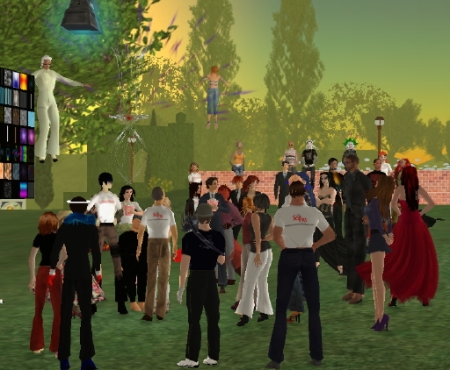
Crowd gathers to see Ira Flatley at the Science School
According to the stately News York Times, radioman Flatow is one of the world’s most influential communicators of science. Apparently, some 3 million people believe it and tune in to his talkfest for two hours every Friday afternoon.
It’s a weekly dialog with scientists during which listeners phone in questions, ideas and opinions.
Ira’s avatar was in-world
That phone-in thing was a little different last Friday when Ira Flatow’s avatar, Ira Flatley, showed up at the Science School sim for a broadcast about our happy little virtual world.
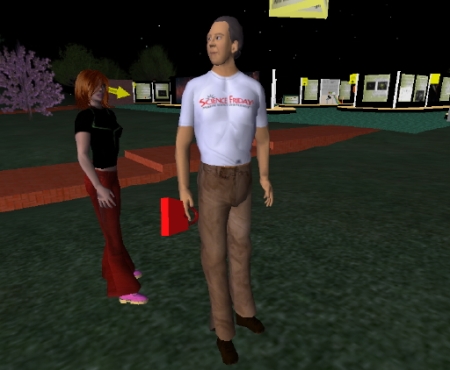
Ira Flatley waits for his cue at the Science School
After a lot of prior publicity, a crowd big enough to bust a sim showed up. That would be about 72 people who got in and a huge bunch of frustrated others spread across the grid who couldn’t get in to see their Mr. Wizard.
Unfortunately, they wouldn’t have been able to see their guy in SL, anyway.
“I’m a SciFri staffer manning Ira’s avatar,” Ira Flatley explained.
The audience was perturbed at that news.
“Aha! Imposter!” OneBigRiver Stork said.
Cybergrrl Oh chimed in, “Oh no – a FAKE IRA.”
I’m “passing your comments to Ira, though,” Ira Flatley replied.
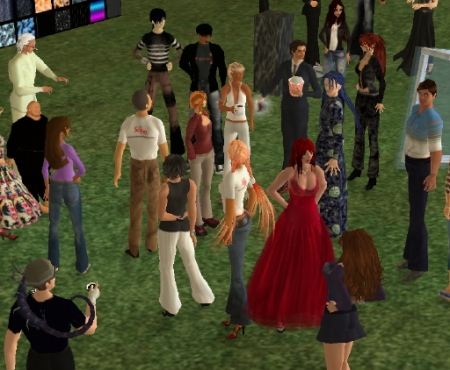
That’s Ira in brown khakis and white SciFri t-shirt with his back to the camera just left of center.
Three scholars and a Linden
Ira Flatow’s live guests for the broadcast –live, that is, from remote studios across the US — were mostly academics:
Dmitri Williams, a professor at the University of Southern California’s Annenberg School for Communication in Los Angeles. USC has it’s International Virtual Worlds Portal for Public Diplomacy here.
Sherry Turkle (SL avatar Rachel Frobozz), director of Massachusetts Institute of Technology’s (MIT) Initiative on Technology and Self, which is a program in science, technology and society at Cambridge, Massachusetts.
Eric Lofgren, a PhD student in epidemiology at the University of North Carolina at Chapel Hill, which has five islands here.
Cory Ondrejka, co-founder and chief technology officer at Linden Lab’s HQ in San Francisco. LL’s village and office is here.
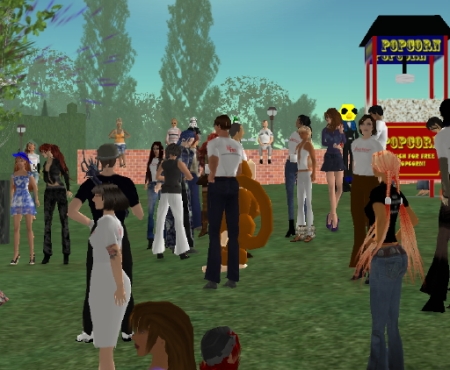
Fans were concerned briefly when Ira crashed out of the overloaded sim. He was back within minutes despite the extreme burden of residents on the land.
Game keeps turning up like a bad penny
It was disappointing to hear Flatow and some of the guests and callers refer repeatedly to Second Life as a game. Anybody who’s been in for any time at all can see it’s not. There are no rules, no scoring, no winners, no losers. There are, of course, outcomes of the type you encounter in the game of life.
Even more unpleasant — dare I say horrifying — was the idea put forth by some scientists who want to use those of us who are residents of virtual worlds as guinea pigs so they can “better understand RL,” as NPR put it in publicity for the show.
Sounds like a nice idea, all warm and fuzzy, right? Well no!
Lofgren proposed unleashing a virtual epidemic in our online community to see what we would do. Like watching mice running through a maze.
The crowd at Science School was aghast.
“So, in a virtual epidemic, could our avatars be killed off permanently? As happens in RL?” wondered Delia Lake.
“I will pass on the epidemic part,” Silvershadow Kleene said.
Brigitte Kungler agreed, “I don’t want to be tested with an epidemic.”
Rebekah Vella foresaw a problem for epidemiology researchers, “An epidemic wouldn’t be taken seriously in a virtual world.”
Hey! We’re real people in here
Second Life is a place where real human beings are behind the keyboards. They bring their RL baggage into this pastime and create a state-of-the-art social networking place — better, I think, than MySpace and Facebook because this world moves. It’s not static and not old-hat.
Facebook claims to be “a social utility that connects you with the people around you.” I would suggest that SL does that and then you can dance to boot.
The broadcast was positive because they didn’t dwell on the male exhibitionists, slave masters and ageplayers on the loose in SL. It would be nice to think mass media finally is getting over that.
Maybe the biggest positive of all…virtual swag. Ira Flatley was handing out SciFri t-shirts from a little red bag he was carrying.
________
Photo: Ira Flatow as host of public television’s Big Ideas in 2003. The broadcaster grew up in Brooklyn and Long Island, NY. He was graduated with a degree in engineering from the State University of New York at Buffalo. He has been reporting on science for NPR since 1971. For several years, he was host and writer of Newton’s Apple, a PBS science program for children. He is 51, married, with three children.
________
Learn more about avatars and how they compare with their RL manifestations: Digital Culture — Alter Egos in a Virtual World
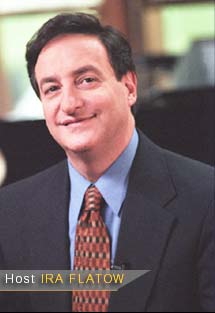
Awesome article it is without doubt. My teacher has been awaiting for this content. I also like the design was this a free theme or a pay one?
It is a very valuable resource and great addition to my
favorites. In this connection, these new features will certainly contribute to social sharing and more rapid progress.